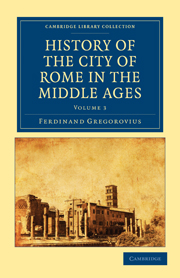CHAPTER VII
Published online by Cambridge University Press: 05 July 2011
Summary
Want of culture in Rome
We dedicate the last chapter of this book to the survey of intellectual culture in the tenth century, and shall close it with a glance at the outward aspect of the city. At scarcely any other period could the barbarism of Rome have been equally great, and since the causes of this barbarism are clear, we can scarcely be surprised at the results. In the age of the Borgias and the Medicis, moral corruption was veiled by an outward show of classic culture; the vices of the Church were hidden behind the tapestries of Raffaelle; but in the tenth century all show of outward beauty was unknown. The portrait of John the Twelfth was as essentially different from that of his remote successor Alexander the Sixth, as was the tenth from the fifteenth century. In the age of Charles, the West, struggling to recover the possession of antique culture, was lighted by a gleam of learning and of art. Poetry, painting and architecture were cultivated. Ancient works were diligently studied and transcribed in legible characters. On the fall of the Carolingian Empire, Saracens, Normans and Hungarians invaded the West; the Papacy became transformed into a Roman barony, and the Western world relapsed into barbarism.
- Type
- Chapter
- Information
- History of the City of Rome in the Middle Ages , pp. 497 - 562Publisher: Cambridge University PressPrint publication year: 2010First published in: 1895

